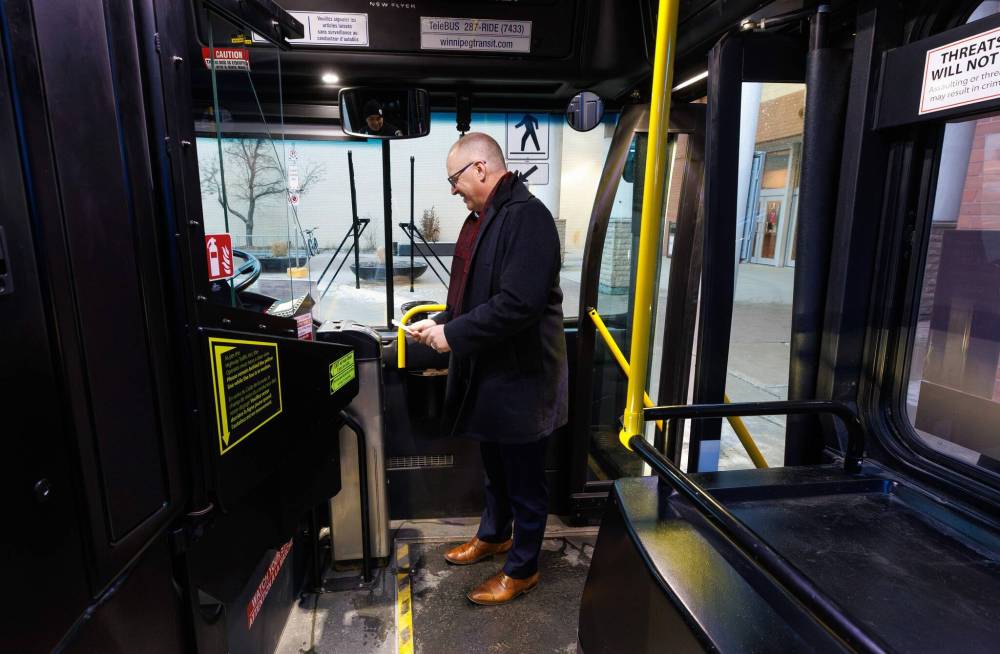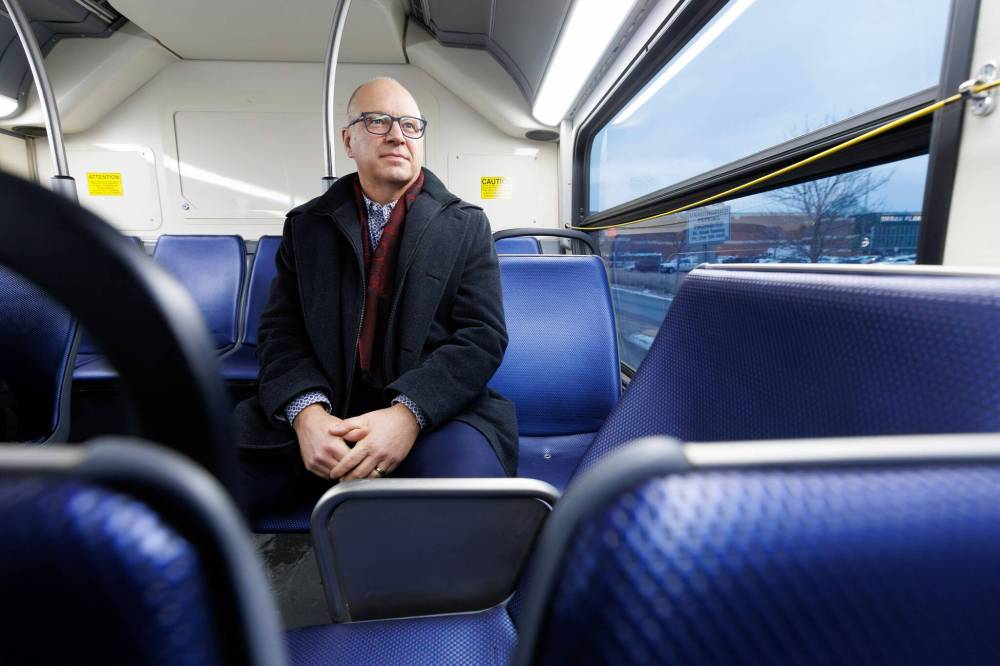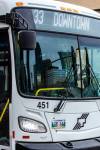Driving Mr. Mayor From the back of the bus, from rider complaints, from the unfilled driver jobs, Scott Gillingham sees the problems with Transit
Read this article for free:
or
Already have an account? Log in here »
To continue reading, please subscribe:
Monthly Digital Subscription
$0 for the first 4 weeks*
- Enjoy unlimited reading on winnipegfreepress.com
- Read the E-Edition, our digital replica newspaper
- Access News Break, our award-winning app
- Play interactive puzzles
*No charge for 4 weeks then price increases to the regular rate of $19.00 plus GST every four weeks. Offer available to new and qualified returning subscribers only. Cancel any time.
Monthly Digital Subscription
$4.75/week*
- Enjoy unlimited reading on winnipegfreepress.com
- Read the E-Edition, our digital replica newspaper
- Access News Break, our award-winning app
- Play interactive puzzles
*Billed as $19 plus GST every four weeks. Cancel any time.
To continue reading, please subscribe:
Add Free Press access to your Brandon Sun subscription for only an additional
$1 for the first 4 weeks*
*Your next subscription payment will increase by $1.00 and you will be charged $16.99 plus GST for four weeks. After four weeks, your payment will increase to $23.99 plus GST every four weeks.
Read unlimited articles for free today:
or
Already have an account? Log in here »
Hey there, time traveller!
This article was published 27/12/2023 (697 days ago), so information in it may no longer be current.
Mayor Scott Gillingham climbs aboard the No. 11 bus at Polo Park around 8 a.m. to begin his commute to city hall.
After paying with his Winnipeg Transit Peggo card, he settles into the second last row of what, at this point, is a near-empty bus.
In Transit
A special series examining the state of Winnipeg’s public transportation system
Even from his perch, the mayor is always the mayor. As the bus slowly fills up with passengers on its way downtown along Portage Avenue, Gillingham is taking stock of what’s happening both inside and outside.
“I can check out the bus shelters, what’s happening, ones that are damaged, ones that have people sleeping (in them),” says Gillingham, joined by a Free Press reporter for a commute in early December.
This bus trip is not simply a photo-op. The mayor tries to take Transit at least twice a month. It allows him to gauge how the service is running and helps guide policy decisions, he says.
Winnipeg Transit has an identity problem. High-profile incidents of violence and stories about service disruptions have shaped the public’s view. But the perception is not always a reflection of the everyday reality.
A few rows back from a code-of-conduct notice posted inside the bus, the mayor notes his rides have been largely uneventful.
“Often, we talk about incidents of aggression… But I think it’s important to point out that every day, thousands and thousands of Winnipeggers are using Transit without incident,” he says.
MIKE DEAL / WINNIPEG FREE PRESS Mayor Scott Gillingham says the driver shortage presents the biggest roadblock to expanding and improving service.
During the 40-minute ride with frequent stops — this wasn’t the express route to city hall — no one is spotted failing to pay a fare, acting aggressively or otherwise disrupting fellow riders. Most passengers keep quiet, with some appearing to fall asleep, or at least close their eyes.
Of course, delays and safety threats can disrupt some rides, with violence and missed buses triggering headlines over the past several years. There were 104 reported assaults against bus drivers in 2022, according to Winnipeg Transit. That marked the highest number since 2000, the earliest year for which data is available.
Another 91 assaults were reported in 2023, as of Oct. 13.
The Amalgamated Transit Union Local 1505, which represents Winnipeg Transit drivers, has said the number is even higher when other security threats are included. ATU reported 208 Transit security incidents as of mid-October, up from 130 throughout 2022, once all types of assault are factored in: attempted assault, verbal threats, steering wheel grabs, shield punches, spitting, attempted robbery, theft, property damage, open liquor, drinks being poured on drivers and use of bear repellent spray.
Meanwhile, a persistent driver shortage has resulted in an increase of service disruption throughout the fall.
That needs to be addressed, Gillingham said, as transit is an essential service for many who have no choice but to rely on buses.
“For a lot of people, it’s the only means of transportation,” he says.
“For a lot of people, it’s the only means of transportation.”–Mayor Scott Gillingham
During a post-ride interview in his office, Gillingham says his vision to modernize bus service largely hinges on ensuring changes in the Winnipeg Transit Master Plan are implemented as soon as possible.
The plan, which was approved by council in April 2021, will redraw nearly all existing bus routes, create a network of six rapid transit corridors, and add electric buses to the fleet over the next two decades.
“I think the Transit Master Plan aims to address some of the barriers for people that prevent them from riding a bus. We need our system to be more frequent and more reliable and those are (at) the heart of the changes that will be made in the implementation of the Transit Master Plan. Traditionally, Winnipeg has been an auto-centric city and there are people right now who perhaps don’t even consider transit an option for them. It doesn’t cross their mind to even consider using transit. But, by my own experience, once I used transit and, in my case, discovered the convenience of it, I (was) more likely to use it,” he says.
Gillingham says a critical piece is a route overhaul that’s currently expected to take effect in June 2025. The new system is slated to introduce a new primary network that will increase the frequency on many routes. A tiered system should see a bus arrive at least every 10 minutes during rush hour and at least every 15 minutes during the rest of the day on top-tier routes.
The mayor notes the driver shortage presents the biggest roadblock to expanding and improving service.
“We need our system to be more frequent and more reliable.”–Mayor Scott Gillingham
By late November, Winnipeg Transit had hired 130 new drivers in 2023 but still fell 109 short of a full complement. At that point, Transit had about 890 active drivers. About 160 to 170 more operators would be needed to provide a full, pre-pandemic service level.
During the 2022 election campaign, Gillingham promised to ensure full service was restored this year but he blames the unfilled positions for keeping that pledge from becoming a reality. Currently, there’s no target date to resume full service.
“We need to be able to recruit and retain Transit operators so we can deliver transit service at 100 per cent of service levels. And, also, we need transit operators so we can effectively deploy the Transit Master Plan,” he said.
He noted that waiting will also be required on additional campaign pledges to add 11 net new buses each year to the busiest routes from 2024 to 2026 and on-demand suburban service, which had been expected to start with Castlebury Meadows-Waterford Green in the city’s northwest quadrant in late 2023.
MIKE DEAL / WINNIPEG FREE PRESS Mayor Scott Gillingham tries to take Transit at least twice a month. 
“What we want to be able to do is, when a new community is established, as soon as possible, get transit service into those communities, so that the people living in those areas see transit as an option for them. It’s key to reducing our greenhouse-gas (emissions), it’s key to having fewer vehicles on the road. So, delivering transit into new residential areas is an important priority … (But) we don’t have enough operators right now to (even) deliver the current service at 100 per cent service levels,” Gillingham said.
The city is taking safety concerns seriously, pointing to the new team of community safety officers who will be devoted to buses and bus stops, which he expects will help retain and attract drivers, he said. The safety officers are expected to begin working in February.
Gillingham’s election platform also called for Transit to test new security measures at major bus stops, such as enhanced lighting and emergency call buttons. He hopes the community safety team can help determine which options would work best and where they are most needed.
While Transit has also heard complaints about passengers who fail to pay their fares, Gillingham says the initial focus of the new safety team won’t be on collecting payment.
“At this point, the focus of the community safety officers is to make sure that the bus is a safe place to be … (and) I don’t want to see our transit operators get into conflict or an adversarial situation where they’re trying to enforce bus fares.
“We want our operators to be safe. So, let’s focus, first of all, at getting the community safety officer team onto our buses, improving the system, making the system safer and I would like to see, too, if there’s a corresponding impact that sees a reduction in fare evasion just by those officers being present.”
joyanne.pursaga@freepress.mb.ca
X: @joyanne_pursaga

Joyanne is city hall reporter for the Winnipeg Free Press. A reporter since 2004, she began covering politics exclusively in 2012, writing on city hall and the Manitoba Legislature for the Winnipeg Sun before joining the Free Press in early 2020. Read more about Joyanne.
Every piece of reporting Joyanne produces is reviewed by an editing team before it is posted online or published in print — part of the Free Press‘s tradition, since 1872, of producing reliable independent journalism. Read more about Free Press’s history and mandate, and learn how our newsroom operates.
Our newsroom depends on a growing audience of readers to power our journalism. If you are not a paid reader, please consider becoming a subscriber.
Our newsroom depends on its audience of readers to power our journalism. Thank you for your support.
History
Updated on Wednesday, December 27, 2023 8:55 AM CST: Checks story tag
















